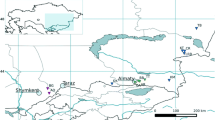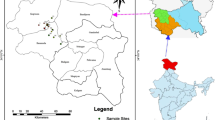Abstract
In order to shed light on the role of Iran in apple evolution and domestication, we chose to investigate the relationships of a collection of 159 accessions of wild and domesticated apples including Iranian indigenous apple cultivars and landraces, selected wild species, and old apple scion and rootstock cultivars from different parts of the world. The majority of the wild species belonged to M. sieversii, which is widely believed to be the main maternal wild ancestor of domestic apples, from Kazakhstan and M. orientalis, which is one of the probable minor ancestors of domestic apples, from Turkey and Russia located on the east and west of Iran, respectively. The accessions were assigned into six arbitrary populations for the purpose of generating information on genetic parameters. Nine simple sequence repeat (SSR) loci selected from previous studies in apple were screened over DNA extracted from all the accessions. Results showed that all SSR loci displayed a very high degree of polymorphism with 11–25 alleles per locus. In total, there were 153 alleles across all loci with an average of 17 alleles per locus. The SSR allelic data were then used for estimation of population genetic parameters, including genetic variation statistics, F-statistics, gene flow, genetic identity, genetic distance and then cluster analysis using POPGENE 1.32 software. The F-statistics and gene flow in particular, showed that there was more intra-population than between population variation. The genetic identity and genetic distance estimates, and the dendrogram generated from the un-weighted pair group arithmetic average (UPGMA) method of cluster analysis showed that the Iranian cultivars and landraces were more closely related to M. sieversii from Central Asia (east of Iran) and M. orientalis native to Turkey and Russia than to other accessions of Malus species. Also, the old apple cultivars from different parts of the world have a closer genetic relationship to M. sieversii, M. orientalis and the Iranian apples, than to other wild species. Based on these results, we suggest that the Iranian apples may occupy an intermediate position between the domesticated varieties and wild species. We propose that Iran could be one of the major players in apples’ domestication and transfer from Central Asia to the western countries.

Similar content being viewed by others
References
Bruford MW, Ciofi C, Funk SM (1998) Characteristics of microsatellites. In: Karp A, Isaac PG, Ingram DS (eds) Molecular tools for screening Biodiversity. Chapman & Hall, London, pp 202–205
Celton J-M, Tustin DS, Chagné D, and Gardiner SE (2008) Construction of a dense genetic linkage map for apple rootstocks using SSRs developed from Malus ESTs and Pyrus genomic sequences. Tree Genetics and Genomes Online First. doi 10.1007/s11295-008-0171-z
Coart E, Vekemans X, Smulders MJM, Wagner I, Huylenbroeck J, Bockstaele E, Roldán-Ruiz I (2003) Genetic variation in the endangered wild apple (Malus sylvestris (L.) Mill.) in Belgium as revealed by amplified fragment length polymorphism and microsatellite markers. Mol Ecol 12:845–857. doi:10.1046/j.1365-294X.2003.01778.x
Coart E, Van Glabeke S, De Loose M, Larsen AS, Roldan-Ruiz I (2006) Chloroplast diversity in the genus Malus: new insights into the relationship between the European wild apple (Malus sylvestris (L.) Mill.) and the domesticated apple (Malus domestica Borkh.). Mol Ecol 15:2171–2182. doi:10.1111/j.1365-294X.2006.02924.x
Damyar S, Hassani D, Dastjerdi R, Hajnajari H, Zeinanloo AA, Fallahi E (2007) Evaluation of Iranian native apple cultivars and genotypes. J Food Agric Environ 5(3&4):207–211
Dunemann F, Kahnau R, Schmidt H (1994) Genetic relationships in Malus evaluated by RAPD ‘fingerprinting’ of cultivars and wild species. Plant Breed 113:150–159. doi:10.1111/j.1439-0523.1994.tb00717.x
Dzhangaliev AD (2003) The wild apple tree of Kazakhstan. Hortic Rev (Am Soc Hortic Sci) 29:63–371
Forsline PL, Aldwinckle HS, Dickson EE, Luby JJ, Hokanson SC (2003) Collection, maintenance, characterization, and utilization of wild apples of central Asia. Hortic Rev (Am Soc Hortic Sci) 29:1–61
Gardiner SE, Bassett HCM, Madie C, Noiton DAM (1996) Isozyme, random amplified polymorphic DNA (RAPD), restriction fragment-length polymorphism (RFLP) markers to deduce a putative parent for the ‘Braeburn’ apple. J Am Soc Hortic Sci 121:996–1001
Hajnajari H (2006) Apple, In: National Fruit Cultivars Collections of Iran; Germplasm and Pomology. Agricultural Education Press, Tehran, Iran
Hamrick JL, Godt MJW (1990) Allozyme diversity in plant species. In: Brown AHD, Clegg MT, Kahler AL, Weir BS (eds) Plant population genetics, breeding, and genetic resources. Sinauer Assoc, Sunderland, Mass, pp 43–63
Harris SA, Robinson JP, Juniper BE (2002) Genetic clues to the origin of the apple. Trends Genet 18:426–430. doi:10.1016/S0168-9525(02)02689-6
Hokanson SC, Szewc-McFadden AK, Lamboy WF, McFerson JR (1998) Microsatellite (SSR) markers reveal genetic identities, genetic diversity and relationships in a Malus × domestica Borkh. core subset collection. Theor Appl Genet 97:671–683. doi:10.1007/s001220050943
Janick J (2005) The origins of fruits, fruit growing, and fruit breeding. Plant Breed Rev 25:255–320
Janick J, Cummins JN, Brown SK, Hemmat M (1996) Apples. In: Janick J, Moore JN (eds) Fruit breeding: tree and tropical fruits. John Wiley & Sons, New york, pp 1–77
Juniper BE (1999) Tracing the origins of the Apple. St. Catherine’s College, Oxford, pp 20–23
Kimura M, Crow JF (1964) The number of alleles that can be maintained in a finite population. Genetics 49:725–738
Khoshbakht K, Hammer K (2006) Savadkouh (Iran) – an evolutionary centre for fruit trees and shrubs. Genet Resour Crop Evol 53:641–651. doi:10.1007/s10722-005-7467-8
Lamboy WF, Yu J, Forsline PL, Weeden NF (1996) Partitioning of allozyme diversity in wild populations of Malus sieversii L. and implications for germplasm collection. J Am Soc Hortic Sci 121:982–987
Larsen AS, Asmussen CB, Coart E, Olrik DC, Kjaer ED (2006) Hybridization and genetic variation in Danish populations of European crab apple (Malus sylvestris). Tree Genet Genomes 2:86–97. doi:10.1007/s11295-005-0030-0
Liebhard R, Gianfranceschi L, Koller B, Ryder CD, Tarchini R, van de Weg E, Gessler C (2002) Development and characterisation of 140 new microsatellites in apple (Malus × domestica Borkh.). Mol Breed 10:217–241. doi:10.1023/A:1020525906332
Lowe A, Harris S, Ashton P (2004) Ecological genetics; design, analysis and application. Blackwell publishing, Oxford
Lunde L (1988) The silk roads; a history. Aramco Services Company, print edition of Saudi Aramco World, vol 39, Number 4, 11–53
Morgan J, Richards A (1993) The book of apples. Ebury Press, London
Nei M (1973) Analysis of gene diversity in subdivided populations. Proc Natl Acad Sci USA 70:3321–3323. doi:10.1073/pnas.70.12.3321
Nei M (1978) Estimation of average heterozygosity and genetic distance from a small number of individuals. Genetics 89:583–590
Pereira-Lorenzo S, Ramos-Cabrer AM, Diaz-Hernandez MB (2007) Evaluation of genetic identity and variation of local apple cultivars (Malus × domestica Borkh.) from Spain using microsatellite markers. Genet Resour Crop Evol 54:405–420. doi:10.1007/s10722-006-0003-7
Pigoloskaya NV, Yakubsky AU, Petroshfsky EP, Belnitsky AM, Estrviva LV (1965) History of Iran; from ancient time up to 18th century. Translated to Persian by Karim Keshavarz in 1965
Ponomarenko V (1987) History of Malus domestica Borkh. origin and evolution. Bot J USSR 176:10–18 (in Russian)
Ponomarenko V (1991) On a little known species Malus × asiatica (Rosaceae). Bot ZH 76:715–720 (in Russian)
Rechinger KH (1963–2001) Flora Iranica, vol 152, Rosaceae, Akademische Druck- u. Verlagsanstalt, Graz
Rehder A (1940) Manual of cultivated trees and shrubs. MacMillan, New York, NY, pp 389–399
Robinson JP, Harris SA, Juniper BE (2001) Taxonomy of the genus Malus Mill. (Rosaceae) with emphasis on the cultivated apple, Malus domestica Borkh. Plant Syst Evol 226:35–58. doi:10.1007/s006060170072
Shannon CE, Weaver W (1949) The mathematical theory of communication. University of Illinois Press, Urbana
Tian-Ming H, Xue-Sen C, Zheng X, Jiang-Sheng G, Pei-Jun L, Wen L, Qing L, Yan W (2007) Using SSR markers to determine the population genetic structure of wild apricot (Prunus armeniaca L.) in the Ily valley of West China. Genet Resour Crop Evol 54:563–572. doi:10.1007/s10722-006-0013-5
Vavilov NI (1926) Studies on the origin of cultivated plants. Tr Byuro Prikl Bot 16:139–245
Wagner I, Weeden NF (2000) Isozymes in Malus sylvestris, Malus × domestica and in related Malus species. Acta Hortic 538:51–56
Wright S (1978) Variability within and among natural populations, vol 4. The Univ. of Chicago Press, Chicago
Yeh FC, Yang RC, Boyle T (1997) POPGENE. CIFOR and University of Alberta, Canada Version 1.21
Acknowledgements
We thank the Ministry of Science, Research and Technology of the Islamic Republic of Iran and the University of Tehran for financial assistance towards travel to and living costs in New Zealand. We also thank HortResearch New Zealand, in particular, the genome mapping laboratory in Palmerston North, for providing the facilities to do this research. We are grateful to Dr Phil. Forsline at the USDA-ARS, Plant Genetic Resource Unit, Cornell University, Geneva, NY, USA. for providing leaf samples from the wild Malus species and Hossein Gharaghani, a masterate student at the College of Agriculture, University of Tehran, for preparing and sending DNA samples from some Iranian accessions.
Author information
Authors and Affiliations
Corresponding author
Rights and permissions
About this article
Cite this article
Gharghani, A., Zamani, Z., Talaie, A. et al. Genetic identity and relationships of Iranian apple (Malus × domestica Borkh.) cultivars and landraces, wild Malus species and representative old apple cultivars based on simple sequence repeat (SSR) marker analysis. Genet Resour Crop Evol 56, 829–842 (2009). https://doi.org/10.1007/s10722-008-9404-0
Received:
Accepted:
Published:
Issue Date:
DOI: https://doi.org/10.1007/s10722-008-9404-0




